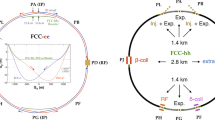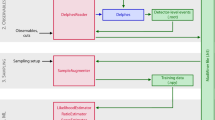
Overview
- This book is open access, which means that you have free and unlimited access
- Explains papers on Higgs particle discovery to help readers to understand articles in high energy physics
- Describes mathematical approaches and concepts including particle identification and statistical processing
- Highlights interconnects between physics and detector technology in experimental particle physics
Part of the book series: Lecture Notes in Physics (LNP, volume 1001)
Buy print copy
Tax calculation will be finalised at checkout
About this book
This open access book offers a concise overview of how data from large scale experiments are analyzed and how technological tools are used in practice, as in the search for new elementary particles. It focuses on interconnects between physics and detector technology in experimental particle physics, and includes descriptions of mathematical approaches. Readers find all the important steps in analysis, including reconstruction of the momentum and energy of particles from detector information, particle identification, and also the general concept of simulating particle production from collisions and detector responses.
As the scale of scientific experiments becomes larger and data-intensive science emerges, the techniques used in the data analysis become ever more complicated, making it difficult for beginners to grasp the overall picture. The book provides an explanation of the idea and concepts behind the methods, helping readers understand journal articles on high energy physics.
This book is engaging as it does not overemphasize mathematical formalism and it gives a lively example of how such methods have been applied to the Higgs particle discovery in the Large Hadron Collider (LHC) experiments, which led to Englert and Higgs being awarded the Nobel Prize in Physics for 2013.
Graduate students and young researchers can easily obtain the required knowledge on how to start data analyses from these notes, without having to spend time in consulting many experts or digesting huge amounts of literature.
Similar content being viewed by others
Keywords
Table of contents (8 chapters)
Authors and Affiliations
About the authors
Kazunori Hanagaki has been a professor at KEK since 2015. He received his Master (1995) and PhD (1998) degrees from Osaka University by the study of CP violation at Fermilab KTeV experiment. He worked on Belle experiment as postdoc researcher at Princeton University, Dzero experiment as Wilson Fellow and Scientist at Fermilab, and joined the ATLAS experiment when he became an associate professor at Osaka University. His current research interest is in Higgs physics and detector development. He has been one of the ATLAS Japan group co-spokespersons since 2015.
Junichi Tanaka has been a professor in the International Center of Elementary Particle Physics (ICEPP), The University of Tokyo (UTokyo) since 2018. He received his Master (1999) and PhD (2002) degrees from UTokyo with studies in the Belle experiment. In 2002, he joined the ATLAS collaboration to search for Higgs boson and new physics beyond the standard model. He was involved in the Higgs search with H → γγ and largely contributed to the discovery of the Higgs boson in 2012. Then, he has worked on the ATLAS calorimeter upgrade, SUSY search etc. with his master and PhD students. He has also worked on computing technologies for high energy physics including grid, cloud, artificial intelligence, quantum computers. He has also joined the Particle Data Group as an encoder of the standard model Higgs since 2017.
Makoto Tomoto has been a professor in KEK since 2020. He received master (1994) and Ph.D. (2001) degrees from Nagoya University by the studies of the track trigger with central drift chamber and B0d B0d mixing at the Belle experiment. He worked on Tevatron/Dzero experiment as a research associate at Fermilab from 2001 to 2006 and joined the ATLAS experiment as an associate professor at Nagoya University in 2006. He devoted his large efforts to measurements of top-quark pair production cross-section at the beginning ofthe ATLAS experiment. His current work focuses on Higgs physics, top-quark physics, and the upgrade of a first-level muon trigger system. He is also involved in detector developments for future collider experiments.
Yuji Yamazaki has been a professor at Kobe University since 2014. He joined the ATLAS experiment in 2007 and has been engaged in a software-based high-level trigger system in ATLAS for muons and recently in muon detector upgrade for the high luminosity LHC. He has also worked on Higgs and top-quark production cross section measurements. Before starting the LHC experiment he was involved in the HERA experiment, a lepton-proton collider at the DESY laboratory in Germany, as a research associate at KEK. There he worked on physics of deep-inelastic scattering, especially on hadronic final state (jets etc.) and diffractive scattering between a virtual photon and proton.
Bibliographic Information
Book Title: Experimental Techniques in Modern High-Energy Physics
Book Subtitle: A Beginner‘s Guide
Authors: Kazunori Hanagaki, Junichi Tanaka, Makoto Tomoto, Yuji Yamazaki
Series Title: Lecture Notes in Physics
DOI: https://doi.org/10.1007/978-4-431-56931-2
Publisher: Springer Tokyo
eBook Packages: Physics and Astronomy, Physics and Astronomy (R0)
Copyright Information: The Editor(s) (if applicable) and The Author(s) 2022
Softcover ISBN: 978-4-431-56929-9Published: 31 January 2023
eBook ISBN: 978-4-431-56931-2Published: 30 January 2023
Series ISSN: 0075-8450
Series E-ISSN: 1616-6361
Edition Number: 1
Number of Pages: XIV, 146
Number of Illustrations: 54 b/w illustrations, 41 illustrations in colour
Topics: Particle and Nuclear Physics, Complex Systems, Statistical Physics and Dynamical Systems



